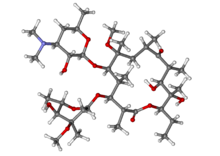|
Klaritromicin
Klaritromicin

|

|
|
|
| Klinički podaci
|
| Robne marke
|
Biaxin, Biaxin XL, Klacid, Klaricid
|
| AHFS/Drugs.com
|
Monografija
|
| Identifikatori
|
| CAS broj
|
81103-11-9
|
| ATC kod
|
J01FA09
|
| PubChem[1][2]
|
5284534
|
| DrugBank
|
DB01211
|
| ChemSpider[3]
|
21112273
|
| KEGG[4]
|
C06912  Y Y
|
| ChEBI
|
CHEBI:3732  Y Y
|
| ChEMBL[5]
|
CHEMBL1741  Y Y
|
| Hemijski podaci
|
| Formula
|
C38H69NO13
|
| Mol. masa
|
747,953
|
| SMILES
|
eMolekuli & PubHem
|
| InChI |
|---|
InChI=1S/C38H69NO13/c1-15-26-38(10,45)31(42)21(4)28(40)19(2)17-37(9,47-14)33(52-35-29(41)25(39(11)12)16-20(3)48-35)22(5)30(23(6)34(44)50-26)51-27-18-36(8,46-13)32(43)24(7)49-27/h19-27,29-33,35,41-43,45H,15-18H2,1-14H3/t19-,20-,21+,22+,23-,24+,25+,26-,27+,29-,30+,31-,32+,33-,35+,36-,37-,38-/m1/s1
Key: AGOYDEPGAOXOCK-KCBOHYOISA-N  Y Y |
|
| Fizički podaci
|
| Tačka topljenja
|
220 °C (428 °F)
|
| Farmakokinetički podaci
|
| Poluvreme eliminacije
|
3-4 h
|
| Izlučivanje
|
urineom
|
| Farmakoinformacioni podaci
|
| Trudnoća
|
?
|
| Pravni status
|
|
| Način primene
|
Oralno
|
Klaritromicin je organsko jedinjenje, koje sadrži 38 atoma ugljenika i ima molekulsku masu od 747,953 Da.[6][7][8][9][10][11][12][13]
Osobine
Reference
- ↑ Li Q, Cheng T, Wang Y, Bryant SH (2010). „PubChem as a public resource for drug discovery.”. Drug Discov Today 15 (23-24): 1052-7. DOI:10.1016/j.drudis.2010.10.003. PMID 20970519. edit
- ↑ Evan E. Bolton, Yanli Wang, Paul A. Thiessen, Stephen H. Bryant (2008). „Chapter 12 PubChem: Integrated Platform of Small Molecules and Biological Activities”. Annual Reports in Computational Chemistry 4: 217-241. DOI:10.1016/S1574-1400(08)00012-1.
- ↑ Hettne KM, Williams AJ, van Mulligen EM, Kleinjans J, Tkachenko V, Kors JA. (2010). „Automatic vs. manual curation of a multi-source chemical dictionary: the impact on text mining”. J Cheminform 2 (1): 3. DOI:10.1186/1758-2946-2-3. PMID 20331846. edit
- ↑ Joanne Wixon, Douglas Kell (2000). „Website Review: The Kyoto Encyclopedia of Genes and Genomes — KEGG”. Yeast 17 (1): 48–55. DOI:10.1002/(SICI)1097-0061(200004)17:1<48::AID-YEA2>3.0.CO;2-H.
- ↑ Gaulton A, Bellis LJ, Bento AP, Chambers J, Davies M, Hersey A, Light Y, McGlinchey S, Michalovich D, Al-Lazikani B, Overington JP. (2012). „ChEMBL: a large-scale bioactivity database for drug discovery”. Nucleic Acids Res 40 (Database issue): D1100-7. DOI:10.1093/nar/gkr777. PMID 21948594. edit
- ↑ Malhotra-Kumar S, Lammens C, Coenen S, Van Herck K, Goossens H: Effect of azithromycin and clarithromycin therapy on pharyngeal carriage of macrolide-resistant streptococci in healthy volunteers: a randomised, double-blind, placebo-controlled study. Lancet. 2007 Feb 10;369(9560):482-90. PMID 17292768
- ↑ Zuckerman JM, Qamar F, Bono BR: Macrolides, ketolides, and glycylcyclines: azithromycin, clarithromycin, telithromycin, tigecycline. Infect Dis Clin North Am. 2009 Dec;23(4):997-1026, ix-x. PMID 19909895
- ↑ Piscitelli SC, Danziger LH, Rodvold KA: Clarithromycin and azithromycin: new macrolide antibiotics. Clin Pharm. 1992 Feb;11(2):137-52. PMID 1312921
- ↑ Peters DH, Clissold SP: Clarithromycin. A review of its antimicrobial activity, pharmacokinetic properties and therapeutic potential. Drugs. 1992 Jul;44(1):117-64. PMID 1379907
- ↑ Clarithromycin. Tuberculosis (Edinb). 2008 Mar;88(2):92-5. PMID 18486039
- ↑ Stephenson GA, Stowell JG, Toma PH, Pfeiffer RR, Byrn SR: Solid-state investigations of erythromycin A dihydrate: structure, NMR spectroscopy, and hygroscopicity. J Pharm Sci. 1997 Nov;86(11):1239-44. PMID 9383733
- ↑ Knox C, Law V, Jewison T, Liu P, Ly S, Frolkis A, Pon A, Banco K, Mak C, Neveu V, Djoumbou Y, Eisner R, Guo AC, Wishart DS (2011). „DrugBank 3.0: a comprehensive resource for omics research on drugs”. Nucleic Acids Res. 39 (Database issue): D1035-41. DOI:10.1093/nar/gkq1126. PMC 3013709. PMID 21059682. edit
- ↑ David S. Wishart, Craig Knox, An Chi Guo, Dean Cheng, Savita Shrivastava, Dan Tzur, Bijaya Gautam, and Murtaza Hassanali (2008). „DrugBank: a knowledgebase for drugs, drug actions and drug targets”. Nucleic Acids Res 36 (Database issue): D901-6. DOI:10.1093/nar/gkm958. PMC 2238889. PMID 18048412. edit
- ↑ Ghose, A.K., Viswanadhan V.N., and Wendoloski, J.J. (1998). „Prediction of Hydrophobic (Lipophilic) Properties of Small Organic Molecules Using Fragment Methods: An Analysis of AlogP and CLogP Methods”. J. Phys. Chem. A 102: 3762-3772. DOI:10.1021/jp980230o.
- ↑ Tetko IV, Tanchuk VY, Kasheva TN, Villa AE. (2001). „Estimation of Aqueous Solubility of Chemical Compounds Using E-State Indices”. Chem Inf. Comput. Sci. 41: 1488-1493. DOI:10.1021/ci000392t. PMID 11749573. edit
- ↑ Ertl P., Rohde B., Selzer P. (2000). „Fast calculation of molecular polar surface area as a sum of fragment based contributions and its application to the prediction of drug transport properties”. J. Med. Chem. 43: 3714-3717. DOI:10.1021/jm000942e. PMID 11020286. edit
Literatura
Vanjske veze
|
|